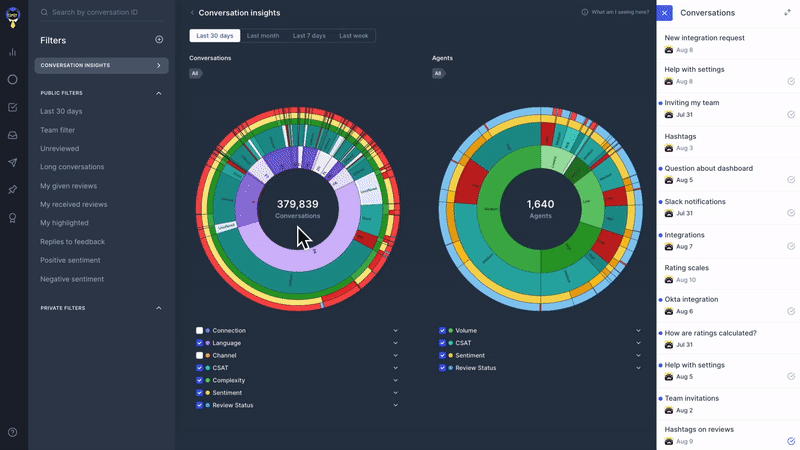Did you know that a cat’s whiskers act as a built-in radar tool to help them navigate and understand their surroundings?
Your data holds a lot of answers to questions you might have about your customer support quality. But data can be difficult to navigate. You need some radar tools.
Whiskers would look silly on humans, so we invented Conversation Insights instead.
Conversation Insights are the visualizations that bring your data to life.
Use them to pounce.

3 Questions Answered by Conversation Insights
1. What is fur-ustrating your customers?
Every customer is different. While there’s no magic recipe for the perfect response, you can at least hack into the conversations where they’re feeling dissatisfied.
CSAT only reflects the conversations your customers have reviewed, but our AI tool analyses 100% of your conversations for customer sentiment. You can find underlying patterns in the conversations our Natural Language Processing models have flagged as containing low sentiment.
What to do:
To see how your conversations divide by Sentiment, center this ring on the Conversations sunburst (on the left) by dragging Sentiment to the top of the checklist. Select ‘Low Sentiment’.
What to look at:
- On the Conversations dial, see how these interactions vary by Complexity, CSAT, etc.
- On the Agents dial, see the characteristics of the agents involved in these interactions.
- The right panel displays all conversations where our AI engine has detected negative sentiment.
How to use this information:
Conversations are put into the low category if the sentiment filter detects customer dissatisfaction in parts of the conversation. When reviewing these conversations, don’t just focus on what the individual agent may have done wrong. Look at the bigger picture.
Are there any patterns in the process followed in each interaction?
Examine which support procedures crop up repeatedly and analyze which changes should be made to your support processes.
Do certain product features crop up often in these conversations?
Feed this information to your product team! Improving customer support quality is about more a stellar customer-facing team, it’s about making your business as a whole more customer-centric. Your product team can put this feedback to good use with updates or future products. It can also help them to build a proper data model of your customer’s sentiment.

2. Where are agents falling behind?
Zendesk QA (formerly Klaus) helps you coach a support team to excellence. Conversation Insights is your go-to for identifying where agents may be struggling; providing you with concrete examples for feedback.
What to do:
Select the low CSAT level and Low Volume on the Agents sunburst (on the right). You can do this either on the sunburst itself or on the checklists below.
What to look at:
- On the Conversations dial, see how these interactions vary by Complexity, CSAT, etc.
- On the Agents dial, see the characteristics of the agents involved in these interactions.
- The right panel displays all relevant conversations.
How to use this information:
We measure agent ticket volume and CSAT scores on a relative scale. This group of agents is narrowed down to those who solve comparatively fewer tickets with lower customer satisfaction ratings than their peers. This signals that they’re struggling.
Are there skill/knowledge gaps which demand further coaching?
In this circumstance, the conversations displayed in the right-hand panel are the most useful for coaching purposes. Dig into the details to find out where there is room for improvement in your onboarding or coaching programs.

3. Where are agents excelling?
Don’t forget to recognize and reward excellent performance! You can also learn from how your best agents are tackling customer problems.
This method detects where customers have displayed dissatisfaction but have ultimately walked away happy. They signal excellent customer experience.
What to do:
Select ‘Low Sentiment’ and the highest CSAT level on the Conversations sunburst (on the left). You can do this either on the sunburst itself or on the checklists below.
What to look at:
- On the Conversations dial, see how these interactions vary by Complexity, CSAT, etc.
- On the Agents dial, see the characteristics of the agents involved in these interactions.
- The right panel displays all conversations in this category.
How to use this information:
In these conversations, your agents are definitely doing something right! Although the customer was initially unhappy, their support experience turned it around.
Are certain agents involved in a large proportion of these conversations?
Make sure these support reps feel appreciated for their efforts. Pin these conversations to give specific positive feedback.
Can you spot new opportunities?
Review these conversations to acquire a better understanding of how these support reps behaved. Maybe they forged new solutions which you can adopt and implement across your team. Perhaps you can incorporate answers to some of the more common problems within FAQs, so customers can self-serve in the future.
Remember:
Zendesk QA compiles and sorts your data using sophisticated AI tools. But advanced interpretation relies just as much on the person using it. Conversation Insights makes that easier.
The more you know your data, the better you can act on it.


